2. Carbon Storage and Sequestration
Carbon Storage and Sequestration

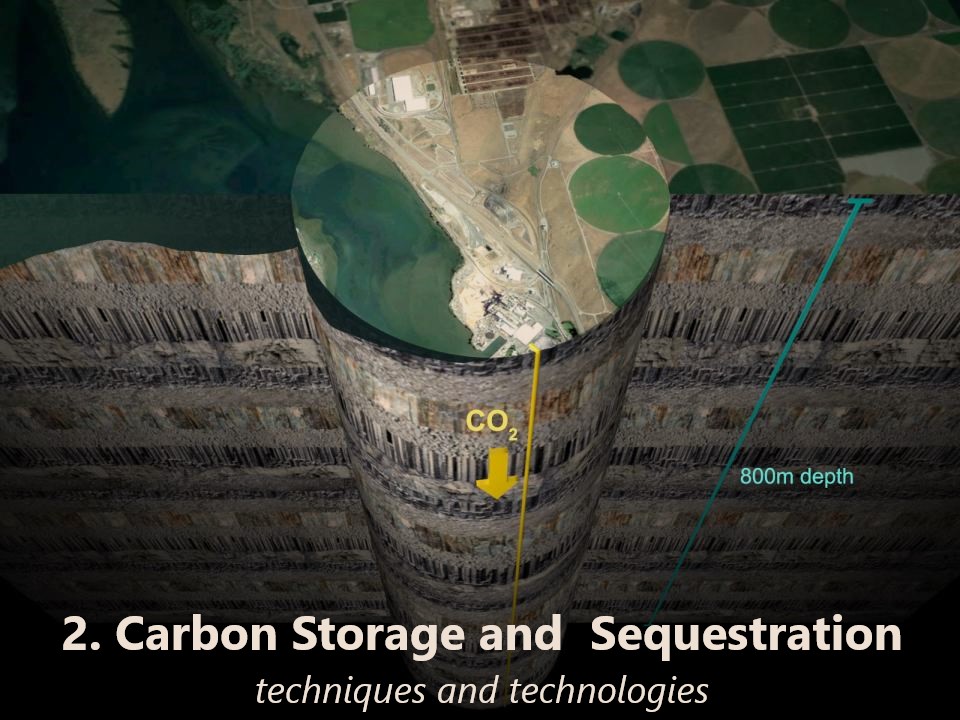
As you sit down to contemplate the many ways in which carbon dioxide (CO2) can be captured, you can't help but feel a sense of awe at the ingenuity and innovation of the various approaches to this complex challenge. You realize that capturing and storing CO2 has the potential to mitigate climate change, reduce greenhouse gas emissions, and provide economic benefits. But as you ponder these possibilities, you also wonder, "How can we do all of this in a responsible way, ensuring that our actions today don't have negative consequences for future generations?"
With this question in mind, you set out on your quest to learn more about carbon storage. As you delve into the subject, you are amazed by the variety of methods and technologies that are used to capture and store CO2. Here’s my attempt to group them in a very generalized way by location of storage:
Underground storage (Geologic storage):
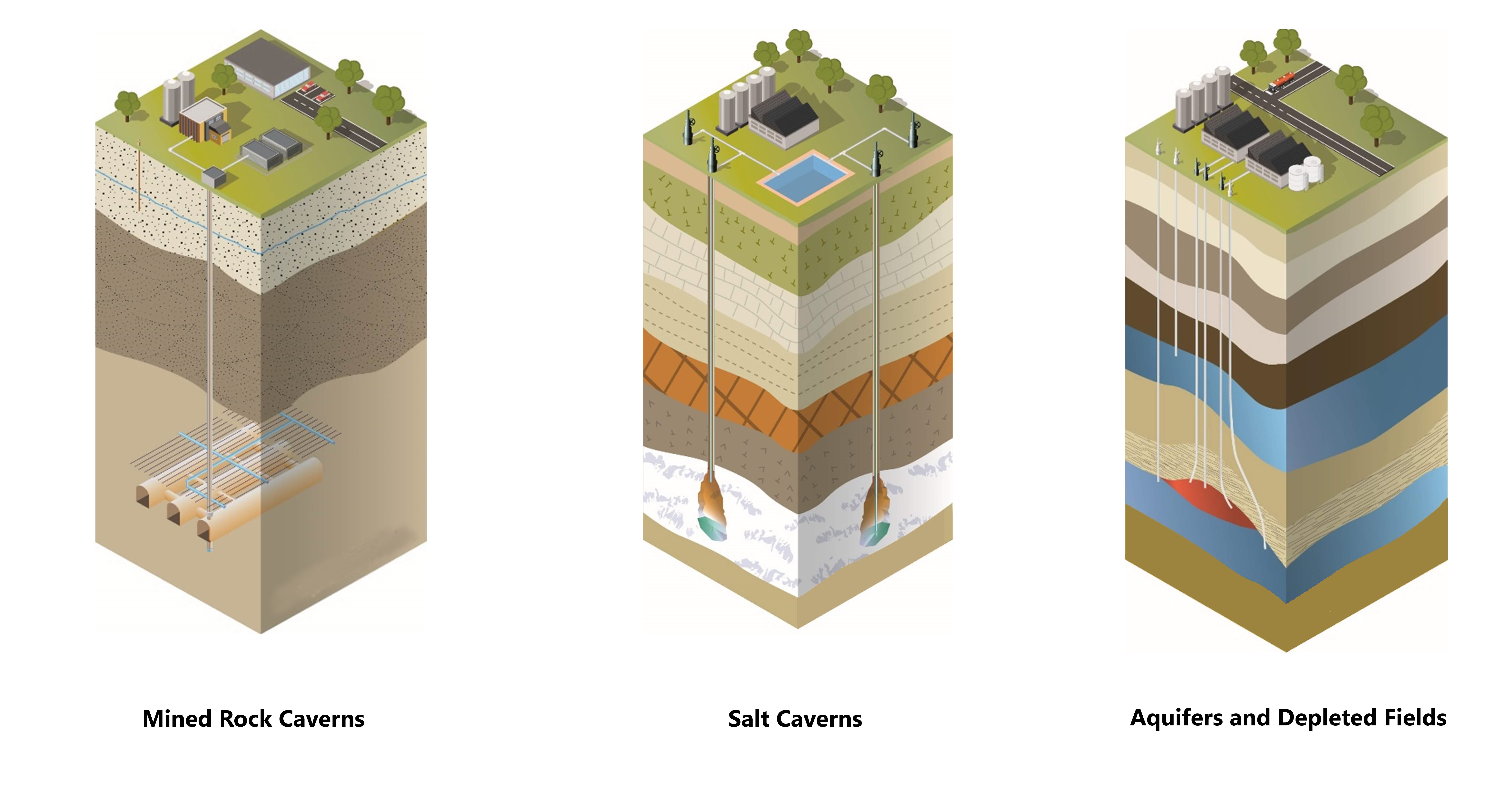
This includes techniques that involve injecting CO2 into underground formations or caverns, such as geological carbon storage (injecting CO2 into geologic formations like saline aquifers or depleted oil and gas reservoirs) and carbon storage in underground caverns (injecting CO2 into abandoned mines or salt domes).
Geological carbon storage and carbon storage in underground caverns are similar methods of capturing and storing CO2 in that they both involve injecting CO2 into underground formations where it can be stored for long periods of time. However, there are some differences between these two methods.
Geological carbon storage involves injecting CO2 into geologic formations, such as saline aquifers or depleted oil and gas reservoirs. These formations are typically located deep underground and are often composed of porous rock, such as sandstone or limestone, which can hold large quantities of CO2.
Examples of Projects:
· The Sleipner project in the North Sea is an example of a large-scale geological carbon storage project that has been successfully operating for over two decades. This project captures and stores CO2 from a natural gas processing plant and injects it into a saline aquifer located deep beneath the seabed.
· The Weyburn-Midale project in Canada - a successful geological carbon storage project that stores CO2 from a coal-fired power plant in a depleted oil and gas reservoir located beneath the surface.
On the other hand, carbon storage in underground caverns involves injecting CO2 into abandoned mines or salt domes, which are large underground structures that can be used to store CO2 for long periods of time. These structures are often located near the surface and are often composed of hard, impermeable rock, such as salt or shale, which can trap and store CO2.
Examples of Projects:
· The Mount Simon project in the United States - a carbon storage project that involves injecting CO2 from a coal-fired power plant into an abandoned mine.
· The In Salah project in Algeria – they capture and store CO2 from a natural gas processing plant and inject it into a salt dome located beneath the surface.
· The Akita project in Japan - a carbon storage project that involves injecting CO2 from a coal-fired power plant and injecting it into an abandoned mine.
Both geological carbon storage and carbon storage in underground caverns face similar challenges. Both techniques can be expensive, as they require specialized equipment and infrastructure to capture and inject CO2 into underground formations. There are also potential risks associated with both techniques, including the potential for leakage from storage sites. In addition, the long-term stability and effectiveness of both techniques is still not fully understood, and further research is needed to understand the potential risks and uncertainties associated with these methods of carbon storage.
Terrestrial storage (Biologic storage, Natural processes):
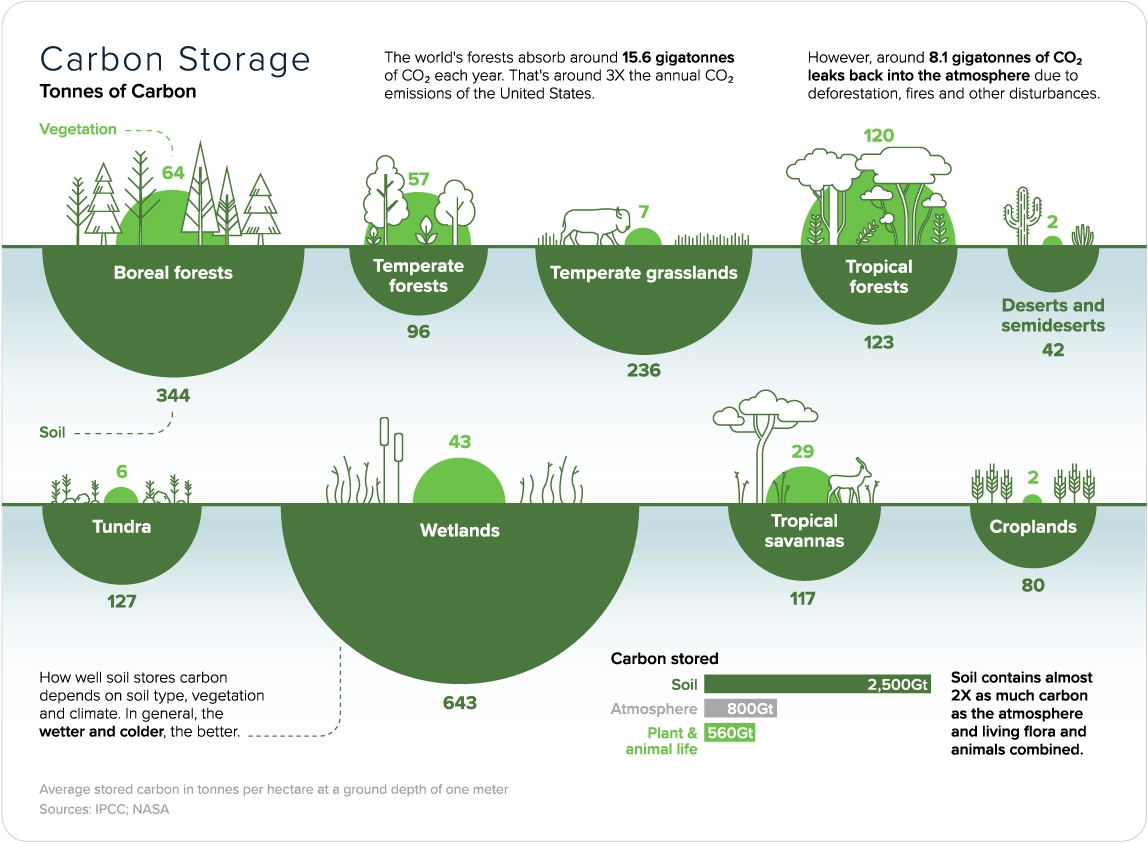
As you continue your journey of discovery, you become increasingly fascinated by the ways in which carbon dioxide (CO2) can be stored in terrestrial environments. You learn about techniques such as carbon storage in biochar, forests, grasslands, and soils, which involve sequestering CO2 in living or once-living organisms or in the soil itself.
One approach that particularly catches your attention is the use of biochar, a form of charcoal produced by heating organic matter in the absence of oxygen. You learn that biochar can be used to sequester carbon in soil, where it can remain for hundreds or even thousands of years. You also discover that biochar has the added benefit of improving soil fertility and water retention, making it a promising tool for sustainable agriculture and land management.
You also learn about the role of forests, grasslands, and soils in sequestering CO2 through photosynthesis and other processes. You are amazed by the vast scale of these natural carbon sinks and the potential for them to help mitigate climate change and reduce greenhouse gas emissions. You also discover that the management of these ecosystems, including practices such as reforestation, afforestation, and regenerative agriculture, can play an important role in enhancing their carbon sequestration potential.
However, there are potential limitations and challenges to terrestrial carbon storage. The effectiveness of these techniques can depend on a variety of factors, including the specific type of vegetation or soil being used, the management practices being employed, and the local climate and environmental conditions. In addition, you learn that terrestrial carbon storage is generally a relatively short-term solution, as the carbon stored in these systems can be released back into the atmosphere through processes such as decomposition or fires.
Here are a few examples of projects and initiatives that are exploring the use of terrestrial carbon storage techniques:
· Biochar initiatives: the Biochar for Soil Health project, funded by the UK's Department for Environment, Food and Rural Affairs, is researching the potential of biochar to sequester carbon in soil and improve soil fertility and water retention.
· Reforestation and afforestation projects: the Billion Tree Campaign, an initiative launched by the United Nations Environment Programme (UNEP) in 2006 with the goal of planting one billion trees worldwide.
· Regenerative agriculture practices: the Carbon Underground project, which aims to accelerate the adoption of regenerative agriculture practices on a global scale.
Ocean storage (Chemical storage):
This includes techniques that involve dissolving CO2 in the oceans, such as ocean fertilization (adding nutrients to stimulate the growth of phytoplankton) and natural ocean carbon sequestration (dissolving CO2 in seawater to form carbonic acid).
Mineral storage (Physical storage):
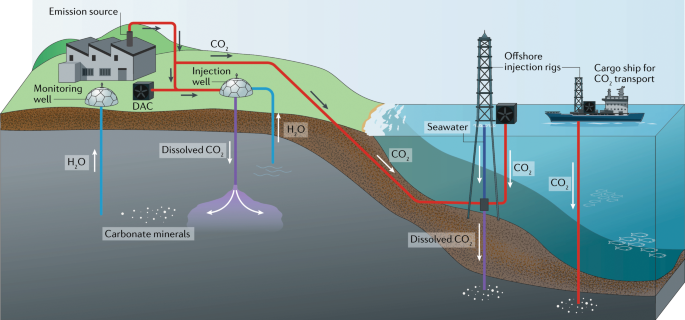
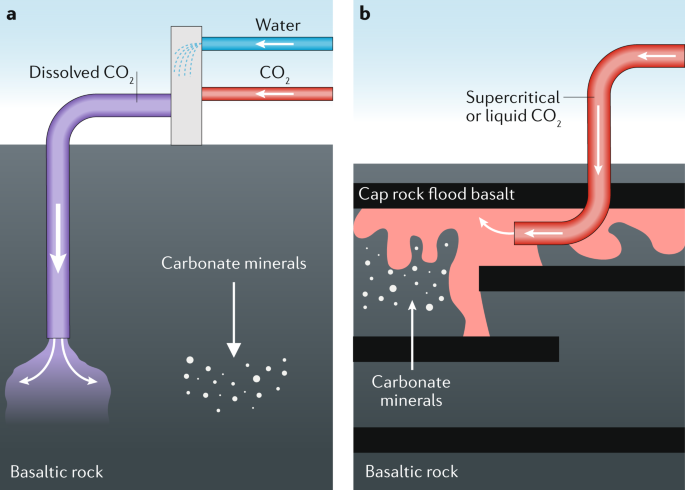
This includes techniques that involve reacting CO2 with naturally occurring minerals to form stable carbonates, such as mineral carbonation.
As you delve deeper into the world of carbon storage, you become increasingly interested in the ways in which CO2 can be stored in the form of stable minerals. You learn about techniques such as mineral carbonation, which involves reacting CO2 with naturally occurring minerals, such as olivine or basalt, to form stable carbonates. These minerals have the potential to sequester CO2 for long periods of time and the process of mineral carbonation is relatively low cost and simple.
While mineral carbonation occurs naturally over geological time scales, it can also be accelerated through human intervention. There are various methods being explored to speed up the process, including grinding the minerals into a fine powder, exposing them to CO2-rich gases, or adding catalysts to the reaction. These techniques have the potential to remove CO2 from the atmosphere and store it in a stable form, which could help mitigate climate change and reduce greenhouse gas emissions.
However, there are also limitations and challenges to consider when it comes to mineral carbon storage. Factors such as the type of mineral being used, the conditions of the reaction, and the presence of other elements that may interfere with the reaction can all impact the effectiveness of this technique. Additionally, the scale of mineral carbon storage is currently limited, as the amount of minerals that can be processed is relatively small compared to the amount of CO2 that is emitted globally.
There are numerous projects and initiatives currently exploring this technique, including:
· Carbon Mineralization Project: The Carbon Mineralization Project is a research initiative funded by the US Department of Energy (DOE) that is exploring the potential of mineral carbonation to sequester CO2 on a large scale. The project is focused on developing technologies and processes that can accelerate the reaction between CO2 and minerals, such as olivine and basalt, and identifying the most effective minerals and conditions for the reaction to occur.
· Carbon Capture Project: The Carbon Capture Project is a research initiative funded by the DOE that is exploring the potential of mineral carbonation to sequester CO2 from power plant emissions. The project is focused on developing technologies and processes that can capture CO2 emissions from power plants and react them with naturally occurring minerals, such as olivine, to form stable carbonates.
· CarbonSafe Project: The CarbonSafe Project is a research initiative funded by the UK's Engineering and Physical Sciences Research Council (EPSRC) that is exploring the potential of mineral carbonation to sequester CO2 from industrial emissions. The project is focused on developing technologies and processes that can capture CO2 emissions from industrial sources and react them with naturally occurring minerals, such as olivine, to form stable carbonates.
· Carbon sequestration in minerals – a Finnish perspective (CARBIMIN): The CARBIMIN project is a research initiative funded by the Academy of Finland that is exploring the potential of mineral carbonation to sequester CO2 in Finland. The project is focused on identifying the most effective minerals and conditions for the reaction to occur, as well as researching the potential benefits and challenges of this technique.
· Mineral Carbonation International (MCi): Mineral Carbonation International (MCi) is a research consortium that is focused on exploring the potential of mineral carbonation to sequester CO2 on a global scale. The consortium brings together researchers from a number of institutions and countries, including Australia, Germany, and the United States, to collaborate on research and development activities related to mineral carbonation.
Product storage (Industrial storage):
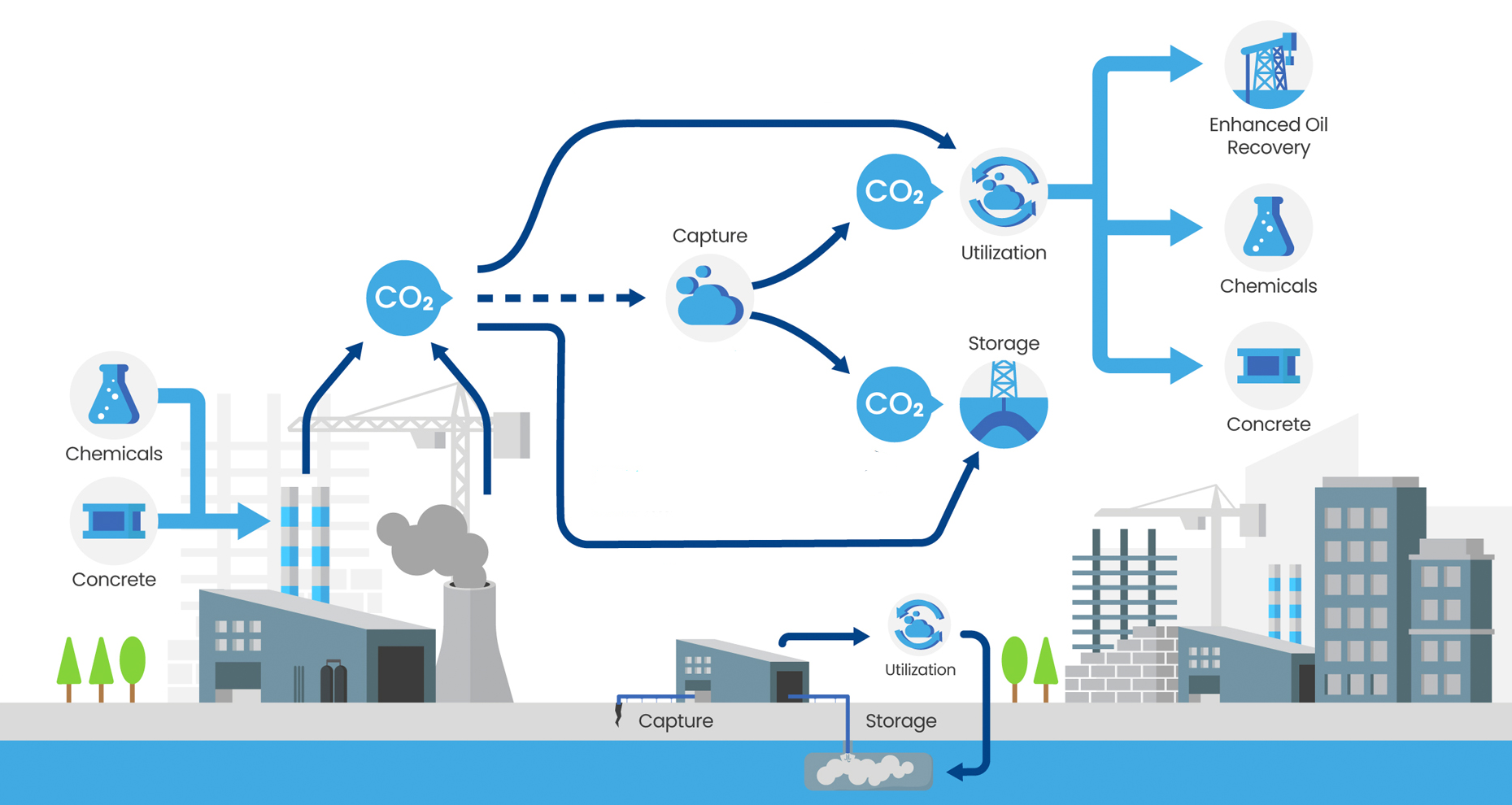
This includes techniques that involve capturing and using CO2 as a feedstock for the production of various products, such as carbon capture and utilization (CCU).
As your knowledge of carbon storage techniques expands, you become particularly interested in the ways in which CO2 can be captured and used as a feedstock for the production of various products. You come across carbon capture and utilization (CCU) and are intrigued by its potential. This method involves capturing CO2 and using them as feedstocks for the production of chemicals, fuels, or other products.
CCU has the potential to not only reduce CO2 emissions but also create value and generate economic benefits. There are a variety of products that can be produced using CCU, including plastics, fuels, and chemicals, and the impressive versatility of this approach.
However, you also become aware of the challenges and limitations of CCU. The economics of this technique depends on various factors, including the cost of capturing and purifying the CO2, the availability of suitable feedstocks and technologies, and the demand for the resulting products. Additionally, CCU can have environmental impacts, such as the use of energy and resources in the production process and the disposal or recycling of the products at the end of their life.
Despite these challenges, CCU has the potential to play a significant role in reducing CO2 emissions and creating economic value. There are various projects and initiatives currently exploring this technique.
CCUS ranking based on Energy Consumption
It is difficult to provide precise estimates of the average energy consumption of different carbon capture, utilization, and storage (CCUS) technologies, as the energy requirements of a particular CCUS technology will depend on a variety of factors, including the specific application, the location of the project, and the efficiency of the technology.
That being said, here is a general overview of the energy requirements of different CCUS technologies, per ton of CO2 captured:
- Post-combustion capture: Post-combustion capture typically requires an energy input of approximately 20-40% of the energy content of the CO2 captured, depending on the specific technology and application.
- Pre-combustion capture: Pre-combustion capture typically requires an energy input of approximately 10-30% of the energy content of the CO2 captured, depending on the specific technology and application.
- Oxy-fuel combustion: Oxy-fuel combustion typically requires an energy input of approximately 20-40% of the energy content of the CO2 captured, depending on the specific technology and application.
- Direct air capture: Direct air capture typically requires an energy input of approximately 10-30% of the energy content of the CO2 captured, depending on the specific technology and application. However, some estimates suggest that the energy requirements of direct air capture could be as high as 50-70% of the energy content of the CO2 captured, depending on the specific technology and application.
- Carbon sequestration in soils: This process does not require any additional energy input, as it occurs naturally as plants and other organic materials decompose in soil.
- Carbon sequestration in oceans: This process does not require any additional energy input, as it occurs naturally as CO2 is dissolved in seawater and taken up by marine plants and animals.
- Carbon sequestration in forests:This process does not require any additional energy input, as it occurs naturally as plants absorb CO2 from the air and store it in their tissue as they grow.
It is important to note that these are rough estimates of the average energy consumption of different CCUS technologies, and the actual energy requirements will depend on a variety of factors. It is also worth noting that the energy consumption of CCUS technologies is likely to decrease over time as technologies are improved and become more efficient.
Tax Credits
There are several tax credits and incentives available in different countries to support the development and deployment of carbon capture, utilization, and storage (CCUS) technologies. These incentives are designed to encourage the use of CCUS technologies and reduce greenhouse gas emissions by providing financial support to companies and organizations that are working on CCUS projects.
In the United States, for example, there are several tax credits and incentives available for CCUS projects, including:
- The Section 45Q tax credit: This tax credit provides a financial incentive for companies and organizations that capture and store CO2 emissions from power plants, industrial facilities, and other sources. The credit is based on the amount of CO2 that is captured and stored, and it can be worth up to $50 per metric ton of CO2.
- The Section 48A investment tax credit: This tax credit provides a financial incentive for companies and organizations that invest in advanced energy projects, including CCUS projects. The credit is based on the amount of money that is invested in the project, and it can be worth up to 30% of the project's cost.
- The Section 48D production tax credit: This tax credit provides a financial incentive for companies and organizations that produce clean electricity using advanced energy technologies, including CCUS technologies. The credit is based on the amount of electricity that is produced, and it can be worth up to $23 per megawatt-hour of electricity.
- The Section 45D production tax credit: This tax credit provides a financial incentive for companies and organizations that produce clean electricity using advanced energy technologies, including technologies that use captured CO2 as a feedstock for chemical production. The credit is based on the amount of electricity that is produced, and it can be worth up to $23 per megawatt-hour of electricity.
There are also several other tax credits and incentives available in the United States for CCUS projects, including grants, loans, and other funding programs.
In Canada, there are several tax credits and incentives available to support the development and deployment of carbon capture, utilization, and storage (CCUS) technologies. These incentives are designed to encourage the use of CCUS technologies and reduce greenhouse gas emissions by providing financial support to companies and organizations that are working on CCUS projects.
Some examples of tax credits and incentives available for CCUS projects in Canada include:
- The Carbon Capture and Storage Investment Tax Credit (CCSITC): This tax credit provides a financial incentive for companies and organizations that invest in CCUS projects. The credit is based on the amount of money that is invested in the project, and it can be worth up to 15% of the project's cost.
- The Carbon Capture and Storage Equipment Incentive (CCSEI): This incentive provides financial support for companies and organizations that purchase and install CCUS equipment. The incentive is based on the cost of the equipment, and it can be worth up to 35% of the equipment's cost.
- The Low Carbon Economy Fund: This fund provides financial support for projects that reduce greenhouse gas emissions, including CCUS projects. The fund is administered by the Government of Canada and provides funding on a competitive basis to eligible projects.
- The Sustainable Development Technology Canada (SDTC) Clean Technology Fund: This fund provides financial support for the development and deployment of clean technology, including CCUS technology. The fund is administered by SDTC, a nonprofit organization that is funded by the Government of Canada.
In other countries, there is also a range of tax credits and incentives available for CCUS projects.